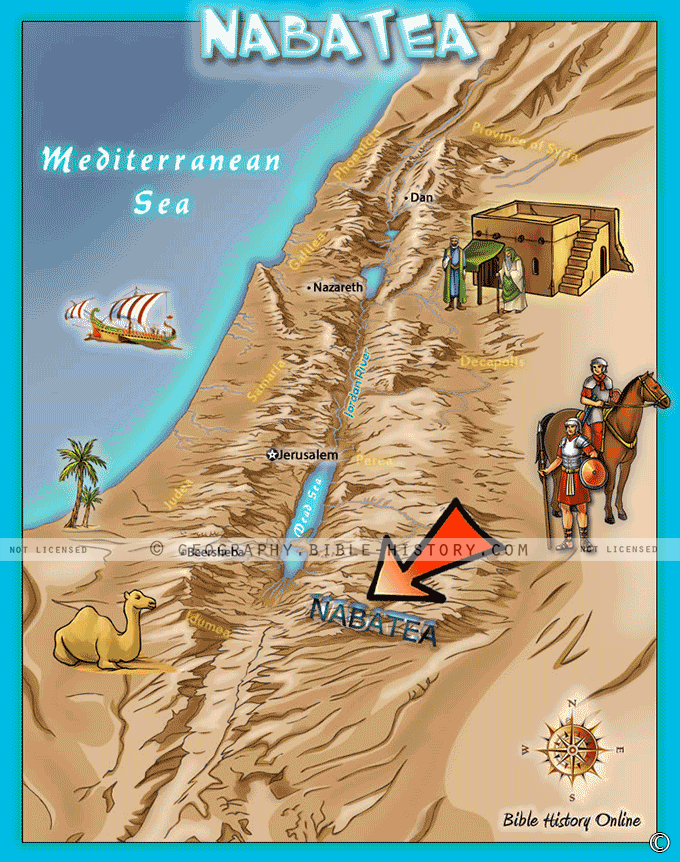
Nabatea stands as a testament to the ingenuity and cultural richness of an ancient civilization that left its mark in the heart of the desert. Nestled within the rocky landscapes of what is now Jordan, this enigmatic realm was home to the Nabateans—a people whose mastery of architecture, trade, and culture created a legacy that continues to captivate the world.
Architectural Marvels in the Desert
The Nabateans' most iconic legacy lies in the stone-carved city of Petra. This ancient metropolis, hidden amidst the rugged terrain, showcases the intricate blending of human artistry with the natural beauty of the landscape. Elaborate facades, temples, and tombs carved directly into the rose-red cliffs reveal the unique aesthetic sensibilities of the Nabateans, offering a glimpse into their architectural prowess.
A Hub of Trade and Culture
Nabatea flourished as a crucial nexus of trade routes that linked the East and West, making it a melting pot of diverse cultures, languages, and ideas. This cultural exchange enriched the Nabateans' lives, enabling them to cultivate a cosmopolitan society that celebrated both innovation and tradition.
Water Engineering Mastery
One of the most remarkable achievements of the Nabateans was their mastery of water management. In a desert environment, they ingeniously harnessed and channeled water through an intricate system of dams, cisterns, and aqueducts. This water engineering expertise not only sustained their civilization but also enabled them to create lush gardens and agricultural terraces amidst the arid landscape.
The Caravan Routes of Nabatea
The caravan routes of Nabatea were the arteries that sustained its economic vitality. From spices and silk to frankincense and myrrh, these routes facilitated the exchange of precious goods across vast distances. The Nabateans' skill in navigating these routes contributed to their wealth and influence, elevating their status on the international stage.
Mysterious Decline
Despite their grandeur and achievements, the Nabateans gradually faded from historical records. The reasons behind their decline remain shrouded in mystery, with factors such as changing trade patterns and geopolitical shifts playing a role. Their legacy, however, lives on through the architectural wonders they left behind.
Nabatea is a glimpse into an ancient world where creativity, trade, and culture converged in the heart of the desert. Its architectural marvels and engineering feats speak of a civilization that left an indelible mark on the landscape. As we explore Nabatea, we peer into a realm where stone and culture intertwined, where the past whispers its stories through the stone-carved facades, and where the Nabateans' legacy endures as a testament to human ingenuity and the enduring spirit of exploration.
Blank Topo Map of The World
Abraham’s Journey
The Captivity of Judah (586-516 B.C.)
The Fall of Judah 586 B.C.
The Northern Kingdom of Israel
The Southern Kingdom of Judah
The Divided Kingdom
The Fertile Crescent
Ur of the Chaldees
Shechem in Old Testament Times
Prophets, Kings, and Nations
Jesus Last Passover
New Testament Israel
New Testament Places
Old Testament Israel
Provinces of the Roman Empire
Israel during David’s Kingdom
David’s Kingdom
Cities of the New Testament 4
Cities of the New Testament 3
Cities of the New Testament 2
Mediterranean Sea
Cities of the New Testament
First Century Jerusalem
Empire of David and Solomon
David’s Kingdom
Israel Under Rehoboam
Ophir and Tarshish
The Period of the Kings
Ramoth Gilead
Samaria
Solomon’s Temple
Zarephath and MT Carmel
Jabesh Gilead and Tribes
Judah in the Time of David
Kingdom of Saul
Kirjath Jearim
Michmash
Mount Gilboa in the Time of David
Nob Davids Flight
Shiloh
Israel and Judah
Assyrian Empire Under Esarhaddon
Assyrian Empire Under Sennacherib
Captivity of 10 Tribes
Events in 2 Kings
The Khabur River
Israel and Syria
Captives From Judah
Kingdom of Jeroboam
Mesha’s Kingdom
Pharaoh Necho Battles King Josiah at Megiddo
Babylonian, Mede and Persian Empires
Samaria and Nearby Territories
Syria at its Height
Hebron
Mahanaim
1949 Map of Israel With Boundaries
First & Second Journeys of Paul
Journeys of the Apostles
Paul’s Third Missionary Journey
Saul’s Journey to Damascus and Arabia
Paul’s Final Visits
Paul’s 1st Missionary Journey
Paul’s 2nd Missionary Journey
Paul’s 3rd Missionary Journey
Paul’s Voyage to Rome
Phillip Journeys to Samaria and Gaza
Judah at the Time of Amos
Empire of Alexander the Great
Israel Under the Maccabees
Galilee During Maccabees
Idumea Intertestamental Period
Kingdom of the Ptolemies
Kingdom of the Seleucids
Ptolemaic Egypt Seleucid Asia
The Roman World
Kingdom of Ptolemies and Seleucids
The World During the 6TH Century BC
Mount Horeb
The Red Sea
The Exodus
Ezra’s Journey to Restore Jerusalem
Israel and Judah During Hosea’s Time
The Ancient World
Canaan During the Time of Abraham
The City of Shechem
Supposed Location of the Garden of Eden
The Land of Israel in Genesis
The Jordan River
The Kingdom of Nimrod
Mount Ararat and Mesopotamia
The Descendants
Sodom and Gomorrah
The Kingdom of Egypt
The Hamites
The Kingdom of the Hittites
Ur of the Chaldees
Judah at the Time of Haggai
Jesus Passes Through Samaria
